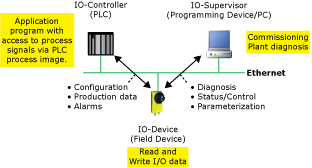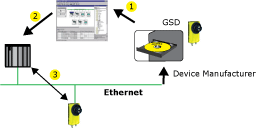PROFINET Communications
Distributed I/O (Remote I/O) is connected through PROFINET IO. In this configuration, which retains the I/O view of PROFIBUS, user data from field devices are periodically transmitted into the process model of the control system.
PROFINET IO describes a device model, which consists of insertion places (slots) and groups of I/O channels (subslots). The technical characteristics of the field devices are described by the GSD (General Station Description) on an XML basis.

PROFINET IO distinguishes between the three following device types:
- IO-Controller: Controller on which the automation program is run.
- IO-Device: A remotely assigned field device, which is assigned to an IO-Controller.
- IO-Supervisor: A programming device (PC), which runs commissioning and diagnostic functions.
The PROFINET IO engineering process is similar to PROFIBUS: Decentralized field buses are assigned to one or more control systems during configuration; the IO-Device is configured to the actual system expansion, based on the content in the GSD file; and the IO-Device is simultaneously integrated, appropriately parameterized and configured into the PROFINET topology (1).
After the engineering process has been completed, the expansion data is loaded into the IO-Controller (2). The IO-Controller independently takes over the data exchange with the IO-Device (3).

The In-Sight system supports PROFINET IO connections from two controllers (or supervisors) at any given time. The steps provided below describe how to use PROFINET IO to transfer data between In-Sight vision systems and a Siemens PLC.